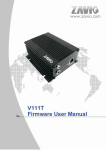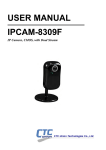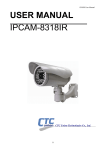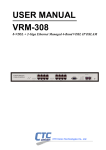Download CTC Union IPCAM-8309FW User manual
Transcript
USER MANUAL DVS-8301 Digital Video Server, 1 ch. Dual Stream CTC Union Technologies Co., Ltd. LEGAL The information in this publication has been carefully checked and is believed to be entirely accurate at the time of publication. CTC Union Technologies assumes no responsibility, however, for possible errors or omissions, or for any consequences resulting from the use of the information contained herein. CTC Union Technologies reserves the right to make changes in its products or product specifications with the intent to improve function or design at any time and without notice and is not required to update this documentation to reflect such changes. CTC Union Technologies makes no warranty, representation, or guarantee regarding the suitability of its products for any particular purpose, nor does CTC Union assume any liability arising out of the application or use of any product and specifically disclaims any and all liability, including without limitation any consequential or incidental damages. CTC Union products are not designed, intended, or authorized for use in systems or applications intended to support or sustain life, or for any other application in which the failure of the product could create a situation where personal injury or death may occur. Should the Buyer purchase or use a CTC Union product for any such unintended or unauthorized application, the Buyer shall indemnify and hold CTC Union Technologies and its officers, employees, subsidiaries, affiliates, and distributors harmless against all claims, costs, damages, expenses, and reasonable attorney fees arising out of, either directly or indirectly, any claim of personal injury or death that may be associated with such unintended or unauthorized use, even if such claim alleges that CTC Union Technologies was negligent regarding the design or manufacture of said product. TRADEMARKS Microsoft is a registered trademark of Microsoft Corp. HyperTerminal™ is a registered trademark of Hilgraeve Inc. User Manual Version 1.0 Oct 2007 First Release This manual supports the following: DVS-8301 This document is the first official release manual. Please check CTC Union's website for any updated manual or contact us by E-mail at [email protected]. Please address any comments for improving this manual or to point out omissions or errors to [email protected]. Thank you. CTC Union maintains a support web site (support.ctcu.com) where you may obtain the latest manual, quick installation guide, and operational firmware. Membership to this web site is free, however, you must be a registered member in order to access any software updates. CTC Union Technologies Co., Ltd. 2008 Copyright, All rights reserved. BEFORE USING THIS PRODUCT This CTC Union product has been designed with safety in mind. However, if not used properly, electrical products can cause fires which may lead to serious bodily injury. To avoid such accidents, be sure to heed the following. Legal Caution: Video and audio surveillance may be forbidden by laws that vary from country to country. Please check the laws in your local region before using this product for surveillance purposes. Heed the safety precautions Be sure to follow the general safety precautions and the “Operation Notice.” In case of a breakdown In case of system breakdown, discontinue use and contact your authorized CTC Union dealer. In case of abnormal operation • If the unit emits smoke or an unusual smell, • If water or other foreign objects enter the cabinet, or • If you drop the unit or damage the cabinet: 1 Disconnect the cable and the connecting cables. 2 Contact your authorized CTC Union dealer or the store where you purchased the product. Operation Notice - Operating or storage location Avoid operating or storing this unit in the following locations: • Extremely hot or cold places (Operating temperature: 0 °C to +50 °C [32 °F to 122°F]) • Exposed to direct sunlight for a long time, or close to heating equipment (e.g., near heaters) • Close to sources of strong magnetism • Close to sources of powerful electromagnetic radiation, such as radios or TV transmitters • Locations subject to strong vibration or shock Ventilation To prevent heat buildup, do not block air circulation around the device. Transportation When transporting the unit, repack it in its original packaging or in materials of equal quality. Cleaning • Use a soft, dry cloth to clean the external surfaces of the device. Stubborn stains can be removed using a soft cloth dampened with a small quantity of detergent solution, then wipe dry. • Do not use volatile solvents such as alcohol, benzene or thinners as they may damage the surface. CHAPTER#1 INSTALLATION CHAPTER#2 USING IP CAMERA VIA MOBILE PHONE CHAPTER#3 USING IP CAMERA VIA WEB BROWSER CHAPTER#4 HOW TO USE 1 2 3 4 4.1. INITIAL ACCESSING THE VIDEO SERVER 5 4.2. CONFIGURATION OF MAIN MENU 6 4.2.1 Setting 4.2.2 Client Setting 4.2.3 Image Setup 4.2.4 PTZ Control 4.2.5 Live View 4.3. BASIC SETTING 4.3.1 System 4.3.2 Camera 4.3.3 Network 4.3.4 Security 4.4. ADVANCE SETTING 4.4.1 PTZ Control 4.4.2 Preset Postion 4.4.3 Patrol 4.4.4 FTP Client 4.4.5 SMTP 4.4.6 HTTP Event 4.4.7 Alarm Output 4.4.8 Schedule 4.4.9 Alarm Input 4.4.10 Alarm Buffer 4.4.11 Motion Detection 4.4.12 System Log 6 7 7 7 8 9 9 12 17 23 25 25 26 27 28 32 37 39 41 42 43 44 45 CHAPTER 1 Installation CHAPTER 1 Installation Installation Steps Follow these steps to install the CTC Union DVS-8301 on your LAN: 1. Check the package contents against the list below. 2. Setup the device. See IP Installer User Manual on the available methods. Package Contents Video Server Power Adapter CD Printed Document CTC Union DVS-8301 1 channel Video Server Country-specific User manual/IP Installer and Documents Quick installation guide Mic In & Line Out Overview Front Panel: Video In Video out Pin1: DI+ Pin3: COM. Pin2:DI- Pin4:N.O. 5~6-Pin : RS485 Rear Panel: Reset LED indicators for power Network / POE connector Power adapter connector 1 CHAPTER 2 Using IP Camera via Mobile Phone CHAPTER 2 Using IP Camera via Mobile Phone To use IP cameras via mobile phones, please make sure your RTSP is set to “ON”. (Default is “ON”) To change the settings of IP cameras, please see “Settings” for details. 3G Mobile Phone viewing For 3G mobile phone viewing, type “rtsp://<IP>:<PORT>/video.3gp” into your 3G web browser. <IP> is the IP address of your IP camera, <PORT> is the RTSP port of your IP camera (Default value is 8554.) Example: rtsp://100.10.10.1:8554/video.3gp Note: • You can also use RTSP clients (RealPlayer, MPlayer, Windows Media Player, Quicktime…etc.) to view RTSP streaming, just type in “rtsp://<IP>:<PORT>/video.3gp” as the Player’s URL 2.5G Mobile Phone viewing For 2.5G mobile phone viewing, type “<IP>/mobile.wml” into your 2.5G web browser. <IP> is the IP address of your IP camera. 2 CHAPTER 3 Using IP Camera via Web Browser CHAPTER 3 Using IP Camera via Web Browser System Requirement To use the product normally, we strongly recommend your computer follows our minimum system requirement (Computer level lower than this might cause some problems) Item Requirements CPU Pentium 4 1600MHz (or equivalent AMD) Graphic Card 64MB RAM graphic cards (or equivalent on-board graphic cards) RAM 512MB Operating System Windows 98, ME (Please see Note) Windows 2000, 2003, XP, Vista Web Browser Internet Explorer 6 or later Note: • If you’re using Windows 98 or ME, please install IP Installer before using WEB UI to ensure the system runs normally. 3 CHAPTER 4 How to Use CHAPTER 4 Configuration This chapter introduces how to monitor the image from the device using Microsoft Internet Explorer web browser. The CTC Union Digital Video Server (DVS) can be used with Microsoft web browsers and Intelligent IP Installer in Windows operation systems. The recommended browser for Windows is Internet Explorer 6.0 or above. If you want to know how to use CTC Union DVS with Intelligent IP Installer, please check the Intelligent IP Installer User’s Manual for Windows operation systems. The functions of the device should be set by the Administrator. For further instructions on setting the device, see “Setting” section. Note: Microsoft's Internet Explorer must be used and the Active-X plug-in embedded in the DVS must be allowed to install in the web browser. The Active-X plug-in is required in order to view video within Internet Explorer. Currently, only Microsoft's browser supports Active-X. Use of other browsers such as Mozilla Firefox or Opera will allow contion but no video will be able to be displayed. If you see no video displayed in you Internet Explorer browser, make sure that the Active-X plug-in was properly installed. 4 4.1. Initially accessing the Video Server 1. Start your web browser, and enter the IP address or host name of the CTC Union IP camera in the Location / Address field of your browser. Note: • If you only want to view the video without seeing the setting page, enter “http://<IP>/index2.htm” as your web URL. 2. Use the default account “admin” and default password “admin”. Note: • The default user name “admin” and the password are set at the factory for the administrator. You can change them in the Account Menu under Setting on page 19. 3. The monitor image will be displayed in your browser. 5 4.2. Configuration of Main Screen Language You can click the pull-down box to select the system language, including English, Traditional Chinese, Simplified Chinese, German, Japanese or Spanish. 4.2.1 Setting This function is only for the Administrator. Click this button to get into the Basic and Advance settings screen. 6 4.2.2 Client Setting Mode: Click the pull-down box to choose between MPEG-4 and M-JPEG (Motion JPEG) video compression modes. Note:MJPEG streaming is unavailable if RTSP mode is ON. View Size: Select the desired display image resolution to 640X480 (4CIF) or 320X240 (CIF). Protocol: Select the transferring protocol from TCP, UDP, HTTP and Multicast. Video Buffer: Turn the Video Buffer function On/Off. The Video Buffer function makes the streaming more smooth in slow or heavy traffic network environment. Buffering might cause a slight delay in live viewing. 4.2.3 Image Setup You can use the tool bar to optimize video brightness, contrast, and saturation. 4.2.4 PTZ Control Pan / Tilt control buttons: Click the arrow button of the direction you want to instruct the Video Server to move the speed dome camera. Other camera control functions: Move the camera to a pre-defined position. Before you start this function, you need to specify Guard tour settings in the Setting Menu under Advance / Patrol setting. Adjust camera focus. Adjust camera optical zoom. 7 4.2.5 Live View Snapshot: You can capture a still image shot from the camera and save it in your computer. 1. Press , and a snapshot window will appear. 2. Click “Save” to save the picture in your computer. 3. Click “Close” to return to the view page. Zoom in / out the image via the monitor window 1. Click to display the digital zoom in window. 2. Pull the to adjust the digital zoom range, and it will be shown on the above window. 3. You can left click your mouse to move the to any location on the window. Audio buttons: :Speakers turned on. :Speakers turned off. :Microphone turned on. :Microphone turned off. : Volume control bar. Note: • It means the speakers of your computer are turned on to transmit the sounds from the connected IP camera(s). Similarly, means you can broadcast to the connected IP camera(s) via the Ethernet using your microphone. Video play buttons: :Pause the current video :Play the video. :Stop the current video. :Record the current video. 8 4.3. Basic SETTING Click the “Basic” menu item to display the sub menus, including System, Camera, Network, and Security. 4.3.1 System 4.3.1.1 Information This information page provides you with product information, including Product name, Firmware version, and Web version. 9 4.3.1.2 Date & Time Setting Current date & time:This displays the current date and time of the device. PC clock:This displays the date and time of the monitoring PC clock. Date & time format:Click the pull-down box to select among different time display formats, including yyyy-mm-dd hh:mm:ss (year-month-day hour:minute:second), mm-dd-yyyy hh:mm:ss (month-day-year hour:minute:second), and dd-mm-yyyy hh:mm:ss (day-month-year hour:minute:second). Adjust:Select one of four time adjusting modes. Keep current setting:Select this mode to keep the current date and time of the device. Synchronize with PC:Select this mode to make the date and time of the device the same as the monitoring PC. Manual setting:Select this mode to manually adjust the date & time of the device. Synchronize with NTP:Specify the NTP server name and the Refresh Interval to synchronize the date and time of the device with those of the time server, known as the NTP (Network Time Protocol) server. Note: • The NTP server (Network Time Protocol) is the time server which is an Internet standard protocol (built on top of TCP/IP) that assures accurate synchronization to the millisecond of computer clock times in a network of computers. NTP server name:Type the host name or IP address of the NTP server, up to 64 characters. Time zone:Select the time zone and time difference from Greenwich Mean Time in the area where the device is installed from the pull-down box. 10 4.3.1.3 Initialization Reboot:Click this button to reboot the device. A confirmation dialogue will appear. Click OK to proceed. It takes about two minutes to reboot the device. Factory default:Click this button to reset the device to the factory default settings. A confirmation dialogue will appear. Click OK to proceed, the network indicator on the device will start to blink. After completing adjustments to the default settings, the device will reboot automatically. Do not turn off the device until the device reboots. Backup setting data:Save the setting data of the device to a file. Click Save, and follow the instructions on the browser to save the setting data file to your specified location. Restore setting:Load the saved setting data of the device. Click Browse and select the file in which the setting data is stored. Click OK, and the device is adjusted according to the loaded data and restarted. Firmware update:Upgrade the device software. Click Browse and select the file for upgrading. A confirmation dialogue will appear. Click OK to start upgrading. The device will reboot upon completion. Note: • Use only upgrade files that are specific for this device. Problems may occur otherwise. • Do not turn off the device power or disconnect the network until the upgrading is completed. 11 4.3.2 Camera 4.3.2.1 General RTSP: Switch the RTSP streaming On/Off. Note: • RTSP: Real Time Streaming Protocol. RTSP is supported by most media clients. (RealPlayer, Media Player, QuickTime, etc…) Deinterlace Filter:Switch the deinterlace filter on/off. Overlay:Select to add Text Overlay or Privacy Mask on/off the display screen. Text Overlay:Enables users to see some information on the display screen, including Date/Time and user-defined text. You can also change the background color. Privacy Mask:Enables users to conceal an area of the video image. 12 4.3.2.2 MPEG-4 Computer View RTSP (If RTSP mode is ON) RTSP port: Specify the transmission port number for RTSP streaming video. Default value is 554. Viewer authentication: If the viewer authentication is ON, users viewing through RTSP will be requested to key-in username and password. RTP (If RTSP mode is ON) Unicast streaming: Unicast streaming Video/Audio port range: Specify the transmission port range for RTP streaming video. RTP will select a port randomly from the range. Multicast streaming: Multicast address: Specify the multicast server address. Video / Audio Port: Specify the transmission port number of the video data. Specify an even number from 1024 to 65534. Time-To-Live: Set the maximum TTL that multicast can pass through. 13 MPEG-4 viewer port (If RTSP mode is OFF) Unicast streaming Video/Audio port number : Specify the transmission port number of the video data. It is initially set to 8090. Specify an even number from 1024 to 65534. Image Size:Specify the image size the network camera transmits. You can choose among 704 × 480, 352 × 240 and 176 × 120 for NTSC mode or 704 × 576, 352 × 288 and 176 × 144 for PAL mode. Frame rate:Set the frame rate of the MPEG4 image. Selectable values are 5, 10, 15, 20, 25, 30 fps. The unit “fps” stands for “frames per second”. Quality Auto:The quality and bitrate will be automatically decided according to the frame rate. Fixed Quality:The selectable values are Medium, Standard, Good, Detailed and Excellent. Fixed Bitrate:Set the bit rate of MPEG-4 image transmission for a line. Selectable values are 64, 128, 256, 384, 512, 768, 1024, 1280, 1536 and 2048 kbps. Note: • The selected frame rate and bit rate are a tentative value. The actual frame rate and bit rate may be different depending on the image size, the shooting scene or the network condition. 14 Mobile View RTSP (If RTSP mode is ON) RTSP port: Specify the transmission port number for RTSP streaming video. Default value is 8554. RTP (If RTSP mode is ON) Unicast streaming: Unicast streaming Video/Audio port range: Specify the transmission port range for RTP streaming video. RTP will select a port randomly from the range. Multicast streaming: Multicast address: Specify the multicast server address. Video / Audio Port: Specify the transmission port number for the video data. Initially it is set to 10000 and 11000. Specify an even number from 1024 to 65534. Time-To-Live: Set the maximum TTL that multicast can pass through. Image Size: The Image size of Mobile view is fixed at 176x120. Frame rate:Set the frame rate of the MPEG-4 image. Selectable values are 5, 10, 15, 20 fps. The unit “fps” stands for “frames per second”. Quality Fixed Bitrate:Set the bit rate of MPEG-4 image transmission for a line. Selectable values are 64, 32, and 16kbps.. 15 4.3.2.3 M-JPEG Note: • Motion JPEG settings are unavailable if the RTSP mode is ON, which means the MJPEG streaming is closed. MJPEG viewer port Unicast streaming Video/Audio port number : Specify the transmission port number for the video data. It is initially set to 8070. Specify an even number from 1024 to 65534. Note: • Unicast streaming:Specify the transmission port number for the video data and audio data used when UDP (Unicast) is selected with the TCP/UDP transmission switching icon in the main viewer. Image Size:Specify the image size the network camera transmits. You can choose among 704 × 480, 352 × 240 and 176 × 120 for NTSC mode or 704 × 576, 352 × 288 and 176 × 144 for PAL mode. Frame rate:Set the frame rate of the M-JPEG image. Selectable values are 5, 10, 15 fps. The unit “fps” stands for “frames per second”. Quality Auto:The quality will be automatically decided. Fixed quality:The selectable values are Medium, Standard, Good, Detailed and Excellent. 16 4.3.3 Network 4.3.3.1 Information MAC address:Displays the MAC address of the device. Obtain an IP address automatically (DHCP):If a DHCP server is installed on the network, to select this so the IP address is assigned by the DHCP server. Note:When you set Obtain an IP address automatically (DHCP), make sure that the DHCP server is working on the network. Use the following IP address:Select this when a fixed IP address is set. IP address:Enter the IP address of the device. Subnet mask:Enter the subnet mask. Default gateway:Enter the default gateway. Use the following DNS server address:Select this when you set the fixed address as the IP address of DNS server. Primary DNS server:Enter the IP address of the primary DNS server. Secondary DNS server:Enter the IP address of the secondary DNS server, if necessary. HTTP port number:Select 80 in general situations. If you want to use a port number other than 80, select the text box and enter a port number between 1024 and 65535. Note:When you have set the HTTP port number to a number other than 80 on the Network setting page or in the Setup Program, access the device by typing the IP address of the device on the web browser as follows: Example: when HTTP port number is set to 2000 Æ http://192.168.0.100:2000/ 17 4.3.3.2 PPPoE Use this setting when you connect the device through PPPoE (Point -to- Point Protocol over Ethernet). PPPoE connection is a protocol that is widely used in xDSL (digital subscriber line such as ADSL, VDSL or SHDSL) as the authentication and connection system. IP address:The IP address obtained from the PPPoE connecting to the network. User ID:Enter the user ID for authentication necessary for PPPoE connections. Type it up to 64 characters. Password:Enter the password for authentication, if necessary, for PPPoE connections. It may be up to 32 characters. Re-type password:Re-type the password to confirm. Obtain DNS server address automatically:Select this to obtain the address of DNS server automatically. Use the following DNS server address:Select this when you set a fixed address as the IP address of DNS server. Primary DNS server:Enter the IP address of the primary DNS server. Secondary DNS server:Enter the IP address of the secondary DNS server. 18 4.3.3.3 DDNS DDNS or Dynamic DNS allows this device to register its IP address with a DDNS service provider. This allows accessing this device by using a real name, rather than having to remember the device's IP address. Server name:Choose the DDNS Server from the list. User ID:Enter the user ID for authentication necessary for DDNS connections. Type it up to 64 characters. Password:Enter the password for authentication necessary for DDNS connections. Type it up to 32 characters. Re-type password:Re-type the password to confirm. Host name:Enter the host name that is registered to the DDNS server. Note: • When you want to use this DDNS function, you need to register an account with a DDNS service provider first. 19 4.3.3.4 UPnP This device includes support for UPnP (Universal Plug 'n Play), which is enabled by default. If also enabled on your computer, the device will automatically be detected and a new icon will be added to “My Network Places.” UPnP provides port forwarding for opening a port in a router or firewall in a private network in order to let a party from the outside world contact a user device inside the firewalled network. HTTP port:Enter the HTTP port number. The default HTTP port is 80. SSL port: Enter the SSL port number. The default SSL port is 443. MPEG-4 viewer port:Enter the MPEG-4 viewer port number. The default MPEG-4 viewer port is 8090. MPEG-4 viewer port(SSL): Enter the MPEG-4 SSL viewer port number. The default is 8091. M-JPEG viewer port:Enter the M-JPEG viewer port number. The default M-JPEG viewer port is 8070. MJPEG viewer port(SSL): Enter the M-JPEG SSL viewer port number. The default is 8071. MPEG-4 RTSP port: Enter the MPEG-4 RTSP port number. The default value is 8050 for computer view, 8030 for mobile view. 20 4.3.3.5 IP Notification When IP notification is set to On, you can send an e-mail notification of the completion of the network settings. Notify type:Select type of DHCP, Static IP and PPPoE setting that will notify. SMTP server name:Type the SMTP server name up to 64 characters, or the IP address of the SMTP server used to relay the email notification messages. Authentication:Select the authentication required when you send an email. Off: Select if no authentication is necessary when an email is sent. On: When authentication is necessary to relay email, select one of the authentication methods from the followings. SMTP: Select if SMTP authentication is necessary when an e-mail is sent. POP before SMTP: Select if POP before SMTP authentication is necessary when an e-mail is sent. 21 Note:When you set to On, be sure to select either or both SMTP or/and POP before SMTP. POP server name:It is necessary when the POP before SMTP is selected in Authentication. Type the POP (receiving mail) server name up to 64 characters, or type the IP address of the POP server. This setting is necessary when the SMTP server which sends e-mails performs authentication using the POP user account. User name, Password:Type the user name and Password of the user who has the mail account. This setting is necessary when the SMTP server which sends e-mails performs authentication. Recipient e-mail address:Type the recipient e-Mail address up to 64 characters. You can specify up to three recipient E-mail addresses. Administrator e-mail address:Type the Administrator e-Mail address up to 64 characters. This address is used for reply mail and sending system messages from the SMTP server. Subject:Type the subject/title of the e-Mail up to 64 characters, with respect to mail which is sent according to the IP notification. Message Type the text of the E-mail up to 384 characters. Default value provides network information including IP, Port, MAC, Model, Firmware Version and Web Version. 22 4.3.4 Security 4.3.4.1 Accounts The device default account and password setting is “admin/admin”. This means anyone might gain access to the device including the configuration as long as the IP address is known. It is necessary to assign a password if the device is intended to be accessed by others. Use this menu to set the user names and passwords of Administrator and up to 9 different users (User 1 to User 9), and the access right of each user. User name:Set a user name between 5 and 16 characters. Password:Set a password between 5 and 16 characters. Re-type password:Re-type the password to confirm. Viewer Mode:Set a user to Admin, Operator or Viewer mode. Viewer authentication:If Off, allows any viewer direct access to Live View without any authentication. 23 4.3.4.2 HTTPS HTTPS is a URI scheme used to indicate a secure HTTP connection. It is syntactically identical to the http:// scheme normally used for accessing resources using HTTP. Using an https: URL indicates that secure HTTP is to be used, but with a different default TCP port (443) and an additional encryption/authentication layer between the HTTP and TCP. You can use the IP camera through HTTPS easily by using https:// instead of http://. Create & Install: Create a self-signed certificate for HTTPS to recognize. Installed Certificate: Display or remove the properties of the installed certificate. HTTPS Connection Policy: Set HTTPS connection policy for different level of users. 24 CHAPTER 4 How to Use 4.4 Advanced Settings 4.4.1 PTZ Control This section explains Pan, Tilt, Zoom, Focus, Iris and Auto Pan speed control settings, as well as the Protocol, Baud rate and Address which depend on the Speed Dome control module. Setting Pan speed:Use it to move bar from 0 to 100. Tilt speed:Use it to move bar from 0 to 100. Zoom speed:Use it to move bar from 0 to 100. Focus speed:Use it to move bar from 0 to 100. Iris speed:Use it to move bar from 0 to 100. Auto Pan speed:Use it to move bar from 0 to 100. Protocol:Include Vtrec, Pelcod, Pelcop, Lilin and Dynacolor. Baud rate:Include 9600, 4800, 2400 and 1200. Address:Type it from 0 to 128. 25 CHAPTER 4 How to Use 4.4.2 Preset Position In this section, up to 32 Pan / Tilt and Zoom positions can be saved, as well as the home position, which the device faces to when the power is turned on. Setting Set:Use it to save the camera position to a preset number. Carry out the following steps. 1. Move the camera to the position to be saved while you are checking the image with the main console. 2. Write the preset position name in Preset Pos. Name text box. 3. Click the SET. The camera position is saved. 4. If want to set this position as home position, click Home option on. Click the SET. The camera position is saved as home position. Note:Setting the new Home position will replace any previously set Home position. Reset:When writing the preset position name in Preset Pos. Name text box, press Reset to clear typed characters. Delete All:Be careful! When pressing Delete All. All Preset Position information will be deleted. Delete:Select a preset number from 1 to 32 in the list box. Use it to delete a specific number preset position setting. 26 4.4.3 Patrol There are four patrol tours to set for composing different preset positions. Each one lists up to 8 positions which can be programmed, and the will camera move to those programmed positions sequentially. The camera stops when it moves to the last preset position. Tour name:Rename the tour name. Tour position Order:There are 8 orders to select for camera directions. Select Pos.:There are up to 32 preset positions to choose for each order. Recall:When you click Recall, the camera moves to position of the selected preset number. Clear:When setting specific preset number position to tour, click Clear to clear this direction information. Clear All:Be careful! When you click Clear All, it will clear this tour all information out. Set:Use it to save the camera position to a preset number. Set as default tour:Click it on to set this tour as default. Tour Start:Click Tour Start, and the camera moves on patrol tour. Tour Stop:While the camera is moving on patrol tour, click Tour Stop to stop the patrol tour. Carry out the following steps: 1. Click “Order” to choose one of eight orders. 2. Click Select Pos. to set the preset position. 3. Click the SET. The tour position is saved. 4. Follow the steps to set the other orders. 5. Click the OK to save the tour. 27 4.4.4 FTP Client Use this setup page to configure capturing and sending of images to an FTP server. By using FTP client function, you can send a video file which has been shot and recorded triggered by the external sensor input, alarm buffer or with the built-in motion detection function to FTP server. FTP client setting menu is composed of three tabs, General, Alarm sending and Periodical sending. 4.4.4.1 General FTP client function:To activate the FTP client function, select On. The FTP client setting page appears. When you do not wish to use the FTP client function, select Off. Note:The frame rate and operability on the main viewer may decrease while a file is being transmitted by the FTP client function. FTP server name:Type the FTP server name to upload still images up to 64 characters, or the IP address of the FTP server. User name:Type the user name for the FTP server. Password:Type the password for the FTP server. Retype password:To confirm the password, type the same characters as you typed in the Password box. Passive mode:Set whether you use the passive or active mode of FTP when connecting to FTP server. Select On to connect to FTP server using the passive mode. Attached file type:Set attached file type to JPEG or MPEG-4. 28 4.4.4.2 Alarm Sending This function is used to forward the image and audio file to the specified FTP server when an alarm is detected by an external sensor input or by the built-in motion detection function. Select On to send the image and audio file to FTP server triggered by alarm detection. Remote path:Type the path to the destination on the FTP server, up to 64 characters. Image file name:Type the file name you want to assign to the images when sending to the FTP server. You can use up to 10 alphanumeric characters, - (hyphen) and _ (underscore) for naming. Please do not leave spaces in the name. Suffix:Select a suffix to add to the file name: Date & time: The date & time suffix is added to the Image file name. The date/time suffix consists of lower two-digits of year (2 digits), month (2 digits), date (2 digits), hour (2 digits), minute (2 digits), second (2 digits), and consecutive number (2 digits), thus 14-digit number is added to the file name. Sequence number: A consecutive number of 10 digits between 0000000001 and 4294967295 and two fixed digits 00 are added to the Image file name. 29 Motion Detection:Click it On to use Motion Detection function as a trigger. You can then setup the motion detection function page. Note: • Motion Detection works only when the Video mode is set to MPEG-4 and the Cropping is set to Off. Alarm Buffer:Select Use alarm buffer when you forward the image/ audio of before and after the alarm detection (pre-alarm, post-alarm). If you do not select it, only the image of the moment of the alarm detection is forwarded. Click Alarm buffer to display the Alarm buffer setting menu. For details, see “Setting the Alarm Buffer — Alarm buffer setting page". Alarm Input: Select the connected alarm. Sensor input1: The external sensor which is connected to sensor input1 of the camera I/O port. Effective period:Set the period when the periodical sending is effective. Always:The periodical sending is always effective. Schedule:You can specify the period when the periodical sending is effective in the schedule setting in the other section. Click Schedule and the setting menu for the effective period is displayed. 30 4.4.4.3 Periodical Sending You can setup to send an image file to FTP server periodically by selecting On to send the image file to FTP server triggered with setting period. Remote path:Type the remote path, up to 64 characters. Image file name:Type the file name of the image sent to FTP server with up to 10 alphanumeric characters, - (hyphen) and _ (under score). Suffix:Select a suffix to be added to the file name sent to FTP server. None:The name of the sent file will be the Image file name. Date & time:The date & time suffix is added to the Image file name. The date & time suffix consists of lower two-digits of year (2 digits), month (2 digits), date (2 digits), hour (2 digits), minute (2 digits) and second (2 digits), and consecutive number (2 digits), thus 14-digit number is added to the file name. Sequence number:A consecutive number is added to the Image file name. Sequence number clear:Click Clear and the suffix of the sequence number returns to 1. Interval:Set the interval to send the periodic image. Minimum value is 1 minute and maximum value is 24 hours. Effective period:Set the period during which the periodical sending is effective. Always:The periodical sending is always effective. Schedule:You can specify the period when the periodical sending is effective in the schedule setting in the other section. Click Schedule and the setting menu for the effective period is displayed. 31 4.4.5 SMTP Use the SMTP setting page when you want to send an image via e-mail. By using the Mail (SMTP) function, you can send a mail with attached image which has been shot triggered by the external sensor input or with the built-in motion detection function. The image file can also be sent periodically. E-Mail (SMTP) setting menu is composed of three tabs, General, Alarm sending and Periodical sending. 4.4.5.1 General Select On when you wish to use the SMTP function. The common setting options are displayed below. If you do not wish to use the e-Mail (SMTP) function, select Off and click OK. Note: • During transmission of an image file via mail, the frame rate and operation performance of the monitor image of the main viewer may be reduced. • While the camera video mode is set to MPEG-4, the image of the composite video signal output from the video output connector of the camera may be distorted during mail transmission. • You cannot send an audio file by using the mail sending function. SMTP server name:Type the SMTP server name, up to 64 characters, or the IP address of the SMTP server. Authentication:Select the authentication method required when you send an email. Off: Select if no authentication is necessary when an email is sent. On: When authentication is necessary to send an e-mail, select one of the authentication methods from the following. 32 SMTP: Select if SMTP authentication is necessary when an e-mail is sent. POP before SMTP: Select if POP before SMTP authentication is necessary when an e-mail is sent. Note: • When you set to On, be sure to select either or both SMTP or/and POP before SMTP. POP server name:This is necessary when the POP before SMTP is selected in Authentication. Type the POP (receiving mail) server name, up to 64 characters, or type the IP address of the POP server. This setting is necessary when the SMTP server which sends e-mails performs authentication using the POP user account. User name, Password:Type the user name and Password of the user who has the mail account. This setting is necessary when the SMTP server which sends e-mails performs authentication. Recipient e-mail address:Type the recipient e-Mail address, up to 64 characters. You can specify up to three recipient E-mail addresses. Administrator e-mail address:Type the Administrator e-Mail address, up to 64 characters. This address is used for reply mail and sending system messages from the SMTP server. Attached File Type: Select to attach the file as JPEG or MPEG-4. Subject:Type the subject/title of the e-Mail, up to 64 characters. With respect to mail which is sent according to the alarm detection when Alarm sending of the alarm tab is set to On, the characters standing for the sensor type are added to the subject. Message:Type the text of the E-mail, up to 384 characters. (A line break is equivalent to 2 characters.) 33 4.4.5.2 Alarm Sending Use this setting page to trigger the email sending in response to an alarm detected by the external sensor input or by the built-in motion detection function. Alarm sending:Select On to set up send mail in response to the alarm detection. File attachment:Set whether an image file is attached to the mail sent or not. When On is selected, the image file made by the settings below is attached. When Off is selected, only the message is sent. Image file name:Type the file name you want to assign to the image to attach a mail. You can use up to 10 alphanumeric, - (hyphen) and _ (underscore) for naming. Suffix:Select a suffix to add to the file name: None: No suffix is added. The Image file name is assigned to the image to be sent via an e-Mail. Date & time: The date & time suffix is added to the Image file name. The date/time suffix consists of lower two-digits of year (2 digits), month (2 digits), date (2 digits), hour (2 digits), minute (2 digits), second (2 digits), and consecutive number (2 digits), thus 14-digit number is added to the file name. Sequence number: A consecutive number of 10 digits between 0000000001 and 4294967295 and two fixed digits 00 is added to the Image file name. Motion Detection:Click this to use the Motion Detection function as a trigger. You can then setup the motion detection function page. Note: • Motion Detection works only when the Video mode is set to MPEG4 and Cropping is set to Off. 34 Alarm Buffer:Select Use alarm buffer when you want to forward the image/ audio of before and after the alarm detection (pre-alarm, post-alarm). If you do not select this, only the image of the moment of the alarm detection is forwarded. Click Alarm buffer to display the Alarm buffer setting menu. For details, see “Setting the Alarm Buffer — Alarm buffer setting Menu on page. Alarm Input: Select the connected alarm. Sensor input1: The external sensor which is connected to sensor input1 of the camera I/O port. Effective period:Set the period when the periodical sending is effective. Always:The periodical sending is always effective. Schedule:You can specify the period when the periodical sending is effective in the schedule setting in the other section. Click Schedule and the setting menu for the effective period is displayed. (“Setting the Schedule — Schedule setting Menu” page). 35 4.4.5.3 Periodical Sending You can setup to send an image file by SMTP server periodically by selecting On to send the image file by SMTP server linked with setting period. Image file name:Type the file name of the image sent by SMTP up to 10 alphanumeric characters, - (hyphen) and _ (under score). Suffix:Select a suffix to be added to the file name sent by SMTP. None:The name of the sent file will be the Image file name. Date & time:The date & time suffix is added to the Image file name. The date & time suffix consists of lower two-digits of year (2 digits), month (2 digits), date (2 digits), hour (2 digits), minute (2 digits) and second (2 digits), and consecutive number (2 digits), thus 14-digit number is added to the file name. Sequence number:A consecutive number is added to the Image file name. Sequence number clear:Click Clear and the suffix of the sequence number returns to 1. Interval:Set the periodical sending interval. Minimum value is 30 minutes and maximum value is 24 hours. Effective period:Set the time period when the periodical sending is effective. Always:The sending function is always active. Schedule:You can specify the period when the periodical sending is effective in the schedule setting in the other section. Click Schedule and the setting menu for the effective period is displayed. (“Setting the Schedule — Schedule setting Menu” page). 36 4.4.6 HTTP Event Use this menu to setup capturing and sending images to an HTTP server. By using HTTP client function, you can send the specified CGI-BIN message linked with the external sensor input or with the built-in motion detection function to HTTP server. HTTP client setting menu is composed of two tabs, General and Alarm sending. 4.4.6.1 General HTTP event: Set up the HTTP server URL, port, user id, password, and proxy server settings. 37 4.4.6.2 Alarm sending Use this page to setup the alarms used to trigger actions such as sending mail, sending to FTP server or sending to HTTP server. Alarm sending:Select On to set the alarm detection action. Motion Detection:Click On to use Motion Detection function as a sensor. You can set the details on the motion detection function page. Note: • Motion Detection works only when the Video mode is set to MPEG4 and Cropping is set to Off. Alarm Buffer:Select Use alarm buffer when you wish to forward the image/ audio of before and after the alarm detection (pre-alarm, post-alarm). If you do not select it, only the image of the moment of the alarm detection is forwarded. Click Alarm buffer to display the Alarm buffer setting menu. For details, see “Setting the Alarm Buffer — Alarm buffer setting Menu on page. Alarm Input: Select the connected alarm. Sensor input1: The external sensor which is connected to sensor input1 of the camera I/O port. Effective period:Set the period when the periodical sending is effective. Always:The periodical sending is always effective. Schedule:You can specify the period when the periodical sending is effective in the schedule setting in the other section. Click Schedule and the setting menu for the effective period is displayed. 38 4.4.7 Alarm Output When you click Alarm output on the Advance mode menu, the Alarm output setting menu appears. You can configure the alarm out of I/O port on the rear of the device linked to the alarm detection and the timer. Setting Alarm output:To activate the Alarm output function, select On. The basic setting options are displayed below. When you do not use the Alarm output function, select Off. Trigger condition:Select the mode of the Alarm output function. You can choose “Alarm” or “Timer”. Alarm: Controls alarm output by synchronizing with an external sensor input or the built-in activity detection function. Motion Detection:Click On to use Motion Detection function as a sensor. You can setup the motion detection function page. Note: Motion Detection works only when the Video mode is set to MPEG4 and the Cropping is set to Off. Use alarm buffer:Select Use alarm buffer when you forward the image/ audio of before and after the alarm detection (pre-alarm, post-alarm). If you do not select it, only the image of the moment of the alarm detection is forwarded. Click Alarm buffer to display the Alarm buffer setting menu. For details, see “Setting the Alarm Buffer — Alarm buffer setting" Menu page. 39 Alarm Input: Control the external alarm input of I/O port on the rear of the device triggering the FTP and SMTP sending function. Click Alarm Input to display the Alarm input setting menu. For details, see “Setting the Alarm Input — Alarm input setting Menu” page. Alarm duration:There are up to 60 second options to choose for alarm duration interval. Effective period:Set the period when the periodical sending is effective. Always:The periodical sending is always effective. Schedule:You can specify the period when the periodical sending is effective in the schedule setting in the other section. Click Schedule and the setting menu for the effective period is displayed. Timer: Controls alarm output by the timer. When clicking “Timer”, a sub window pops up. Set the Recording time of Pre-alarm period and Post-alarm period. The recording time may be up to 5 seconds. Schedule:You can specify the period when the periodical sending is effective in the schedule setting in the other section. Click Schedule and the setting menu for the effective period is displayed. 40 4.4.8 Schedule When you click Schedule on the Advance mode menu, the Schedule setting menu appears. This is the same menu as the setting menu which is displayed when you click Schedule to set Effective period and Schedule in FTP client setting menu, e-Mail (SMTP) setting menu, Alarm out setting menu and so on. Example: When setting e-Mail (SMTP) (the alarm sending) in the Schedule setting menu. Setting Schedule selection Select the list box to specify the schedule you want to set. e-Mail (SMTP) – Alarm, e-Mail (SMTP) – Periodical, FTP – Alarm, FTP – Periodical, HTTP event – Alarm, Alarm output – Alarm or Alarm output – Timer, can be selected. Mon (Monday) to Sun (Sunday) The time period on the right of the checked day is the effective period of the schedule. Start time, End time Specify the Start time and the End time. Use the same time schedule every day When this is checked, the Start time and End time set to Mon (Monday) are applied to all days. In this case, the Start time and End time of the other days than Mon (Monday) cannot be input. 41 Chapter#4 How to Use 4.4.9 Alarm Input When you click Alarm Input on the Advance mode menu, the Alarm input setting menu appears. You can set in this menu to control the external alarm input of I/O port on the rear of the device triggering the FTP and SMTP sending functions. Setting Sensor input 1:Click On to use external sensor which is connected to sensor input1 of the camera I/O port. Trigger condition: Select “High” or “Low”. Camera move: Pull down the window to select the camera preset position. 42 Chapter#4 How to Use 4.4.10 Alarm Buffer On this page you can set the Pre-alarm image and audio (the image and audio before the alarm detection) and the Post - alarm image and audio. These can be set when Alarm sending FTP client setting menu or Image memory setting menu is set to On, and also when Use alarm buffer is selected. Setting Video Mode: The video mode of alarm buffer is MPEG-4. Alarm buffer:To activate the Alarm buffer function, select On. The basic setting options are displayed below. When you do not use the Alarm output function, select Off. Recording capacity Pre-alarm period:Display the maximum recording capacity of image/audio before the alarm detection. Post-alarm period:Display the maximum recording capacity of image/audio after the alarm detection. Recording time Set the recording time for the Pre-alarm image/audio and Post alarm image/audio. Pre alarm period:Type it with recording time of the image/audio before the alarm detection. Post alarm period:Type it with recording time of the image/audio after the alarm detection. Note: • The value of Recording capacity differs depending on Image size, bit rate (for MPEG4) and Image quality (for MPEG4 and MJPEG) in the camera setting menu. 43 Chapter#4 How to Use 4.4.11 Motion Detection When you click Motion Detection on the Advance mode menu, the Motion Detection setting menu appears. There are three Motion Detection functions which act as sensors and can be set for different detecting zones. Each one has Threshold and Sensitivity inputs which you can adjust to specific zone sequentially. Motion Detection function can support triggering for FTP, SMTP and Alarm output for capturing and sending images or starting alarm output. If you do not wish to use the Motion Detection function, click it Off and press OK. Motion Detection 1:Click On to use Motion Detection 1 function as a sensor. You can adjust and move the detecting zone by using mouse. Motion Detection 2:Click On to use Motion Detection 2 function as a sensor. You can adjust and move the detecting zone by using mouse. Motion Detection 3:Click On to use Motion Detection 3 function as a sensor. You can adjust and move the detecting zone by using mouse. Threshold:You can use the tool bar to set up-limit value. When detecting zone signals are over setting value, it would carry on assigned work. Sensitivity:You can use the tool bar to set down-limit value. When detecting zone signals are over setting value, it would carry on assigned work. Carry out the following steps: 1. Click On Motion Detection 1, choose one of eight orders. 2. A detecting zone 1 appears. Use mouse to adjust and move the zone boundaries and position. 3. Use tool bar to set Threshold and Sensitivity value. 4. Follow the steps to set the other Motion Detection. 5. Click OK to save the setting. Note: Warning! Motion Detection function doesn’t work with Patrol function at the same time. 44 Chapter#4 How to Use 4.4.12 System Log The System Log function allows users to review any changes and events that have happened. The system starts logging automatically after started. Remote Log: Enables user to send the log data to a specified log server. 45 DVS Series CTC Union Technologies Co., Ltd. Far Eastern Vienna Technology Center (Neihu Technology Park) 8F, No.60, Zhouzi Street Neihu District, Taipei 114, Taiwan Phone:(886) 2.2659.1021 Fax:(886) 2.2799.1355 E-mail: [email protected] Url:http://www.ctcu.com































































